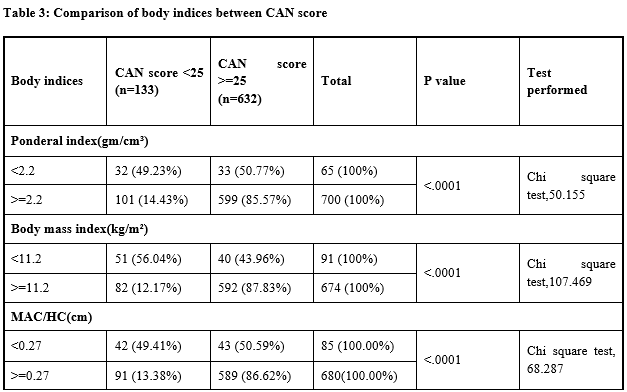Comparative Assessment of Fetal Malnutrition by Anthropometry and CAN Score with associated maternal factors in Sub-District hospital of Uttarakhand
Abstract
Introduction: Fetal malnutrition is an important contributor to perinatal mortality and morbidity. This study was aimed to assess the nutritional status of the newborn at birth using Clinical Assessment of Nutrition (CAN score) and compare it with other conventional anthropometric indices. In addition to studying maternal variables associated with fetal malnutrition.
Material and Methods: This prospective study was conducted at Sub-District hospital, Uttarakhand for a 3-month duration from June 2020 to August 2020. Total 765 term, singleton newborn without major congenital malformation or comorbidities were included in the study. Anthropometric indices and CAN score were assessed and compared.
Results: The incidence of fetal malnutrition was 17.39% using the CAN score. Fetal malnutrition was detected in 133(17.3%), 65(8.5%), 141(18.4%), 91(11.8%), 85(11.1%) of newborn using CAN score, PI, Gestational age, BMI, and MAC/HC respectively. Out of clinically malnourished babies identified by CAN score, PI, gestational age, BMI and MAC/HC identified 49.23% (32), 76.6% (108), 56.04%(51), 49.41%(42) as fetal malnutrition. BMI has the highest sensitivity and diagnostic accuracy for detecting fetal malnutrition. Maternal variables associated with FM include early maternal age during conception 81.4% (623), primigravida 33.1% (112), anemia (21%), irregular antenatal checkups (40%) and concurrent illnesses (PIH, urinary tract infection, heart disease, renal disease, vascular disease) (50.9%).
Conclusion: CAN score is a simple, handy and cost-effective tool to identify FM. Using BMI with CAN score can serve for screening FM. Among maternal variables, primigravida (33.1), anemia (21.5%), irregular antenatal checkup (40.25%), Concurrent medical illnesses (50.96%) is strongly associated with FM. Maternal age is not statistically significant.
Downloads
References
Battaglia FC, Lubchenco LO. A practical classification of newborn infants by weight and gestational age. J Pediatr. 1967;71(2):159–63
Soundarya M, Basavaprabhu A, Raghuveera K, et al. Comparative Assessment of Fetal Malnutrition by Anthropometry and CAN Score. Iran J Pediatr. 2012 Mar; 22 (1):70-6.
Metcoff J. Clinical assessment of nutritional status at birth. Fetal malnutrition and SGA are not synonymous. Pediatr Clin North Am. 1994 Oct;41(5):875-91.
Scott KK, Usher RH. Fetal malnutrition: Incidence, causes and effects. Amer J Obstetr1966; 94(7): 951-63.
Jayant D, Rajkumar J. Study of the prevalence and high-risk factors for fetal malnutrition in term newborns. Ann Trop Paediatr. 1999; 19:273–77.
Crosby WM. Studies in fetal malnutrition. Am J Dis Child. 1991; 145:871-6.
Mohan M, Prasad SR, Chellani HK, et al. Intrauterine growth curves in North Indian babies: weight, length, head circumference and Ponderal index. Ind Pediatr1990; 27(1):43-51.
Georgieff MK, Sasanow SR, Chockalingam UM, et al. A comparison of midarm circumference/head circumference ratio and Ponderal index for evaluation of mentally retarded infants after abnormal intrauterine growth. Acta PediatrScand1988; 77(2):214-9.
Brock RS, Falcao MC, Leone C. Body mass index values for newborns according to gestational age. Nutr Hosp 2008; 23(5):487–92.
Adebami OJ, Owa JA, Oyedeji GA, et al. Prevalence and problems of fetal malnutrition in term babies at Wesley Guild Hospital, South Western Nigeria. West Afr J Med. 2007; 26(4):278–82.
Vikram singhal, Prashanth Agal, Nutan Kamath. Detection of Fetal Malnutrition by CAN score at birth and its comparison with other methods of determining Intrauterine Growth. Indian Journal of Clinical Practice. April 2012;22 (11):576-82
Dr AbhaykumarDhanorkar, Dr Prashant Bagdey, Dr Arun Humne. Detection of Fetal Malnutrition at birth by clinical assessment of nutritional status score. Health sciences: An International Journal. 2014; 4(1):1-5.
Sankhyan N, Sharma VK, Singh S. Detection of fetal malnutrition using "CAN score". Indian J Pediatr. 2009 Sep;76(9):903-6. doi: 10.1007/s12098-009-0196-9. Epub 2009 Nov 4.
Carrera JM, Devesa R, Salvador J. Aetiology and pathogenesis of intrauterine growth restriction. In: Kurjak A, editor. Textbook of Perinatal Medicine. London: Parthenon Publishing; 1998. p. 1171-91.
Ezenwa BN, Iroha EO, Ezeaka VC, Egri-Okwaji MT. Comparative study of Clinical Assessment of Nutritional status score and proportionality indices in the assessment of fetal malnutrition in term newborns. Niger Med J 2016;57:124-8. doi: 10.4103/0300-1652.182075.
Janardhan AM et al.Detection of fetal malnutrition and its associated maternal factors in a rural setting. Int J Contemp Pediatr. 2020 Sep;7(9):1880-1884, DOI: http://dx.doi.org/10.18203/2349-3291.ijcp20203647

Copyright (c) 2021 Author (s). Published by Siddharth Health Research and Social Welfare Society

This work is licensed under a Creative Commons Attribution 4.0 International License.


 OAI - Open Archives Initiative
OAI - Open Archives Initiative


